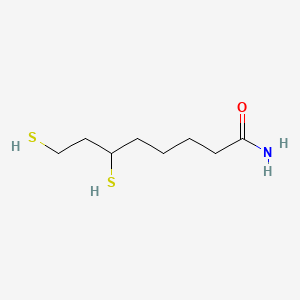| MeSH term | MeSH ID | Detail |
|---|---|---|
| Parkinsonian Disorders | D020734 | 20 associated lipids |
Dihydrolipoamide
Dihydrolipoamide is a lipid of Fatty Acyls (FA) class. Dihydrolipoamide is associated with abnormalities such as Wiskott-Aldrich Syndrome. The involved functions are known as Citric Acid Cycle, Electron Transport, NADH oxidation, Oxidation and Oxidants. Dihydrolipoamide often locates in Mitochondria, Mitochondrial matrix and Chloroplasts. The associated genes with Dihydrolipoamide are Mutant Proteins, Recombinant Proteins, mycothione reductase, Genes, Mitochondrial and alanylproline.
Cross Reference
Introduction
To understand associated biological information of Dihydrolipoamide, we collected biological information of abnormalities, associated pathways, cellular/molecular locations, biological functions, related genes/proteins, lipids and common seen animal/experimental models with organized paragraphs from literatures.
What diseases are associated with Dihydrolipoamide?
Dihydrolipoamide is suspected in and other diseases in descending order of the highest number of associated sentences.
Related references are mostly published in these journals:
| Disease | Cross reference | Weighted score | Related literature |
|---|
Possible diseases from mapped MeSH terms on references
We collected disease MeSH terms mapped to the references associated with Dihydrolipoamide
PubChem Associated disorders and diseases
What pathways are associated with Dihydrolipoamide
There are no associated biomedical information in the current reference collection.
PubChem Biomolecular Interactions and Pathways
Link to PubChem Biomolecular Interactions and PathwaysWhat cellular locations are associated with Dihydrolipoamide?
Visualization in cellular structure
Associated locations are in red color. Not associated locations are in black.
Related references are published most in these journals:
| Location | Cross reference | Weighted score | Related literatures |
|---|
What functions are associated with Dihydrolipoamide?
Related references are published most in these journals:
| Function | Cross reference | Weighted score | Related literatures |
|---|
What lipids are associated with Dihydrolipoamide?
There are no associated biomedical information in the current reference collection.
What genes are associated with Dihydrolipoamide?
Related references are published most in these journals:
| Gene | Cross reference | Weighted score | Related literatures |
|---|
What common seen animal models are associated with Dihydrolipoamide?
There are no associated biomedical information in the current reference collection.
NCBI Entrez Crosslinks
All references with Dihydrolipoamide
Download all related citations| Authors | Title | Published | Journal | PubMed Link |
|---|---|---|---|---|
| Ajith VK and Prasad R | A novel protein that binds to dnrN-dnrO intergenic region of Streptomyces peucetius purified by DNA affinity capture has dihydrolipoamide dehydrogenase activity. | 2009 | Protein Expr. Purif. | pmid:19481152 |
| Kurakin A | Scale-free flow of life: on the biology, economics, and physics of the cell. | 2009 | Theor Biol Med Model | pmid:19416527 |
| Matthews RG | A love affair with vitamins. | 2009 | J. Biol. Chem. | pmid:19596855 |
| Xiao Z et al. | Acetoin catabolism and acetylbutanediol formation by Bacillus pumilus in a chemically defined medium. | 2009 | PLoS ONE | pmid:19461961 |
| Charles RC et al. | Comparative proteomic analysis of the PhoP regulon in Salmonella enterica serovar Typhi versus Typhimurium. | 2009 | PLoS ONE | pmid:19746165 |
| Günther S et al. | Knockout studies reveal an important role of Plasmodium lipoic acid protein ligase A1 for asexual blood stage parasite survival. | 2009 | PLoS ONE | pmid:19434237 |
| Ambrus A et al. | Inhibition of the alpha-ketoglutarate dehydrogenase-mediated reactive oxygen species generation by lipoic acid. | 2009 | J. Neurochem. | pmid:19393031 |
| Ndifon W et al. | On the accessibility of adaptive phenotypes of a bacterial metabolic network. | 2009 | PLoS Comput. Biol. | pmid:19696877 |
| Johnson M et al. | Maternal enzyme masks the phenotype of mouse embryos lacking dihydrolipoamide dehydrogenase. | 2009 | Reprod. Biomed. Online | pmid:19573295 |
| Li BW et al. | Transcriptomes and pathways associated with infectivity, survival and immunogenicity in Brugia malayi L3. | 2009 | BMC Genomics | pmid:19527522 |
| Xie L et al. | A unified statistical model to support local sequence order independent similarity searching for ligand-binding sites and its application to genome-based drug discovery. | 2009 | Bioinformatics | pmid:19478004 |
| Stern JM et al. | Radiofrequency ablation of small renal cortical tumours in healthy adults: renal function preservation and intermediate oncological outcome. | 2009 | BJU Int. | pmid:19426196 |
| Marino SM and Gladyshev VN | A structure-based approach for detection of thiol oxidoreductases and their catalytic redox-active cysteine residues. | 2009 | PLoS Comput. Biol. | pmid:19424433 |
| White JR et al. | Statistical methods for detecting differentially abundant features in clinical metagenomic samples. | 2009 | PLoS Comput. Biol. | pmid:19360128 |
| Ramos EI et al. | 2,3-diphenyl-1,4-naphthoquinone: a potential chemotherapeutic agent against Trypanosoma cruzi. | 2009 | J. Parasitol. | pmid:18788881 |
| Hohenester S et al. | Primary biliary cirrhosis. | 2009 | Semin Immunopathol | pmid:19603170 |
| Wang Q et al. | Genome sequence of the versatile fish pathogen Edwardsiella tarda provides insights into its adaptation to broad host ranges and intracellular niches. | 2009 | PLoS ONE | pmid:19865481 |
| Li J et al. | Pivotal role of the C-terminal DW-motif in mediating inhibition of pyruvate dehydrogenase kinase 2 by dichloroacetate. | 2009 | J. Biol. Chem. | pmid:19833728 |
| Tyagi TK et al. | Moonlighting protein in Starkeyomyces koorchalomoides: characterization of dihydrolipoamide dehydrogenase as a protein acetyltransferase utilizing acetoxycoumarin as the acetyl group donor. | 2009 | Biochimie | pmid:19383527 |
| Spalding MD and Prigge ST | The amidase domain of lipoamidase specifically inactivates lipoylated proteins in vivo. | 2009 | PLoS ONE | pmid:19812687 |
